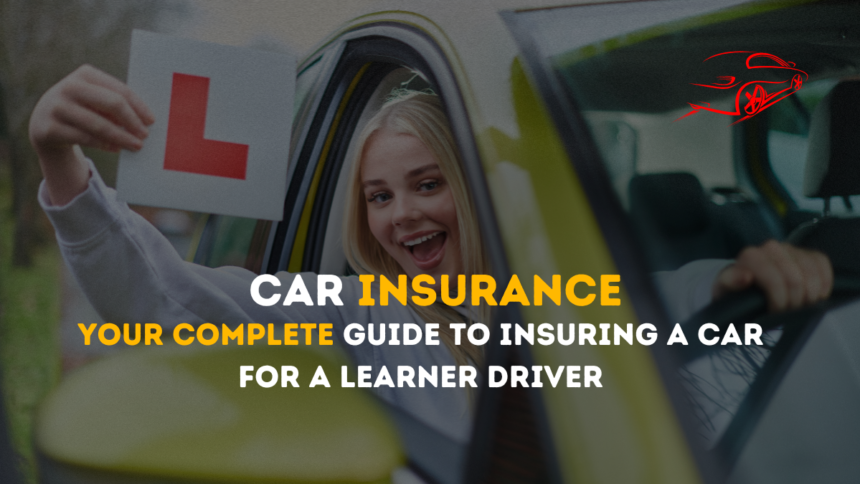Introduction
Are you a learner driver wondering how to get your car insured? Look no further, because this complete guide has got you covered. Insuring a car for a learner driver can be confusing and overwhelming, but with the right information, you’ll be able to navigate the process with ease.
In this comprehensive article, we’ll walk you through everything you need to know about insuring a car as a learner driver. From understanding the different types of insurance available to find the best deals and discounts, we’ve got all the tips and tricks to help you save money and get the coverage you need.
We’ll also address common questions and concerns that learner drivers have about car insurance, such as how to add a learner driver to an existing policy and what to consider when choosing a car for a learner driver.
By the end of this guide, you’ll have the knowledge and confidence to make informed decisions when it comes to insuring a car for a learner driver. So let’s dive in and get you on the road to affordable and comprehensive coverage!
Understanding car insurance for learner drivers
As a learner driver, navigating the world of car insurance can be a daunting task. It’s essential to have a solid understanding of the different types of coverage available and how they apply to your unique situation. Car insurance for learner drivers is designed to provide the necessary protection while you’re still in the learning phase of your driving journey.
One of the key things to understand is that learner drivers are generally considered a higher-risk group when it comes to car insurance. This is because statistics show that inexperienced drivers are more likely to be involved in accidents or make mistakes on the road. As a result, insurance providers often charge higher premiums for learner drivers to offset this increased risk.
However, this doesn’t mean that you’re doomed to pay exorbitant rates. With the right knowledge and strategies, you can find affordable car insurance that meets your needs as a learner driver. In the following sections, we’ll explore the various types of car insurance available, the factors that affect premiums, and practical tips to help you secure the best coverage at the best price.
The importance of insuring a learner driver
Insuring a car for a learner driver is crucial for several reasons. Firstly, it provides the necessary legal protection in the event of an accident. In most jurisdictions, it’s a legal requirement to have a minimum level of car insurance coverage before you can get behind the wheel. Driving without insurance can result in hefty fines, license suspension, and even criminal charges.
Beyond the legal aspect, car insurance for learner drivers also offers financial protection. Accidents can be costly, and without proper coverage, you could be left responsible for paying for damages, medical expenses, and other related costs out of your pocket. This can be a significant financial burden, especially for young or inexperienced drivers who may not have the resources to cover such expenses.
Additionally, having car insurance can provide peace of mind for both the learner driver and their family or friends. Knowing that you’re covered in the event of an accident can help alleviate the stress and anxiety that often comes with the learning process. This can allow you to focus on developing your driving skills and gaining the confidence you need to become a safe and responsible driver.
Types of car insurance for learner drivers
When it comes to car insurance for learner drivers, there are several different types of coverage to consider. The most common options include:
Learner Driver Insurance
Learner driver insurance is a specific type of car insurance policy designed for individuals who are in the process of learning to drive. This coverage is typically added to an existing car insurance policy, either as an endorsement or a separate policy. Learner driver insurance provides the necessary liability coverage and may also include additional benefits, such as coverage for the supervising driver or the ability to build up no-claim discounts.
Provisional License Insurance
Provisional license insurance is similar to learner driver insurance, but it’s specifically tailored for drivers who have a provisional or learner’s permit. This type of coverage is often more affordable than standard car insurance, as it recognizes the increased risk associated with inexperienced drivers.
Named Driver Insurance
Named driver insurance allows you to be added as a secondary driver on someone else’s car insurance policy, such as a parent or guardian. This can be a cost-effective option for learner drivers, as it allows you to benefit from the primary policyholder’s experience and potentially lower rates.
-as-you-go Insurance
Pay-as-you-go insurance, also known as telematics or black box insurance, is a type of car insurance that uses a GPS device installed in your vehicle to monitor your driving behavior. This can result in lower premiums for learner drivers who demonstrate safe and responsible driving habits.
It’s important to carefully evaluate the different types of car insurance available and choose the option that best suits your needs and budget as a learner driver. Be sure to compare quotes from multiple providers and consider the specific coverage, deductibles, and any additional benefits that may be included.
Factors that affect car insurance premiums for learner drivers
When it comes to car insurance premiums for learner drivers, several factors can influence the cost. Understanding these factors can help you make informed decisions and potentially find more affordable coverage.
Age and Experience
As mentioned earlier, learner drivers are generally considered a higher-risk group due to their lack of experience. Younger drivers, typically those under the age of 25, tend to have higher insurance premiums than more experienced drivers. This is because statistics show that younger drivers are more likely to be involved in accidents or engage in risky driving behaviors.
Type of Vehicle
The type of vehicle you choose to learn to drive in can also impact your car insurance premiums. Larger, more powerful vehicles or luxury models tend to have higher insurance costs due to the increased risk of accidents and the higher repair or replacement costs. Opting for a smaller, more practical vehicle can help keep your insurance premiums more manageable.
History
If you have any previous driving experience, even if it’s not as a primary driver, your driving history can also influence your car insurance rates. Factors such as any past accidents, traffic violations, or claims can all contribute to higher premiums. Maintaining a clean driving record can help you secure more favorable rates as a learner driver.
The geographic location where you live can also play a role in your car insurance premiums. Areas with higher population density, more traffic congestion, or higher rates of car theft or vandalism may have higher insurance costs. Additionally, certain regions may have different legal requirements or regulations that can impact the cost of coverage.
Levels
The level of coverage you choose can also affect your car insurance premiums. Higher levels of liability coverage, comprehensive coverage, or additional features like roadside assistance can increase the overall cost of your policy. Carefully evaluating your coverage needs and finding the right balance between protection and affordability is crucial.
By understanding these key factors, you can better navigate the car insurance landscape and make informed decisions that can help you find the most affordable coverage as a learner driver.
Tips for finding affordable car insurance for learner drivers
Securing affordable car insurance as a learner driver can be a challenge, but with the right strategies, you can find coverage that fits your budget. Here are some tips to help you get the best deals:
Around and compare quotes
Don’t settle for the first quote you receive. Take the time to shop around and compare offers from multiple insurance providers. This will allow you to find the most competitive rates and ensure you’re getting the best value for your money.
Consider adding a more experienced driver to the policy
Adding a more experienced driver, such as a parent or guardian, to your car insurance policy can help lower your premiums. The presence of a more experienced driver can offset the perceived risk associated with a learner driver, resulting in lower rates.
Look for discounts and special programs.
Many insurance providers offer discounts and special programs specifically designed for learner drivers. These may include good student discounts, defensive driving course discounts, or even special policies tailored for young or inexperienced drivers. Be sure to inquire about any available discounts or programs that you may qualify for.
Opt for a higher deductible.
Choosing a higher deductible, the amount you pay out of pocket before your insurance coverage kicks in can help lower your monthly premiums. However, be sure to choose a deductible that you can comfortably afford in the event of a claim.
-as-you-go insurance
As mentioned earlier, pay-as-you-go or telematics insurance can be a cost-effective option for learner drivers. These policies use in-car devices or mobile apps to monitor your driving behavior, and you’re charged based on your actual driving habits rather than a flat rate.
Maintain a clean driving record.
Avoiding accidents, traffic violations, and claims can go a long way in keeping your car insurance premiums low. Demonstrating safe and responsible driving habits can help you secure more favorable rates as a learner driver.
Review your policy regularly.
Don’t just set and forget your car insurance policy. Review it periodically to ensure you’re still getting the best deal. As your driving experience and situation change, your insurance needs may also evolve, so be sure to explore any potential savings or coverage adjustments.
By implementing these strategies, you can increase your chances of finding affordable car insurance that provides the necessary coverage and protection as a learner driver.
How to add a learner driver to an existing car insurance policy
If you’re a learner driver and you have access to a vehicle that is already insured, you may be able to add yourself to the existing car insurance policy. This can be a convenient and potentially more cost-effective option compared to purchasing a separate policy. Here’s how to go about it:
With the primary policyholder
The first step is to discuss the process with the primary policyholder, who is typically the vehicle owner or the main driver of the policy. Explain your situation as a learner driver and your need to be added to the existing policy.
Provide the necessary information.
The insurance provider will likely require specific information about you as the learner driver, such as your name, date of birth, driver’s license details, and any previous driving experience. Be prepared to provide this information to facilitate the process.
d the impact on the policy
Adding a learner driver to an existing car insurance policy may result in changes to the premium. The insurance provider will assess the risk associated with the additional driver and adjust the rates accordingly. It’s important to have a clear understanding of how this will affect the overall cost of the policy.
the policy coverage
Ensure that the existing policy provides the necessary coverage and protection for you as a learner driver. This may include liability coverage, collision coverage, and any additional features that you deem important. If the coverage is not adequate, you may need to consider upgrading the policy or exploring alternative options.
Discuss any exclusions or limitations.
Some car insurance policies may have specific exclusions or limitations when it comes to learner drivers. For example, there may be restrictions on the types of vehicles you’re allowed to drive or the maximum number of hours you can spend behind the wheel. Be sure to understand these details to avoid any potential issues or surprises down the line.
Obtain written confirmation
Once the process is complete, make sure to obtain written confirmation from the insurance provider that you have been successfully added to the policy. This will serve as proof of your coverage and can be helpful if any questions or claims arise in the future.
By following these steps, you can seamlessly add yourself as a learner driver to an existing car insurance policy, ensuring that you’re properly covered and protected while you work towards obtaining your full driver’s license.
Steps to take before allowing a learner driver to drive your car
If you’re the owner of a vehicle and you’re considering allowing a learner driver to operate it, there are several important steps you should take to ensure the safety of both the learner and your vehicle. Here’s what you should do:
Ensure the learner driver is properly insured
The first and most crucial step is to make sure the learner driver has the appropriate car insurance coverage in place. This may involve adding the learner driver to your existing policy or ensuring they have their separate policy that provides the necessary liability and coverage protection.
the learner’s driver’s permit or license
Confirm that the learner driver has a valid learner’s permit or provisional license and that they are legally allowed to operate a vehicle, either on their own or with a supervising driver present. This will help avoid any legal issues or complications down the line.
Assess the learner driver’s skills and experience.
Take the time to evaluate the learner driver’s current driving skills and experience. Observe their performance in a controlled environment, such as a parking lot or a quiet residential area, before allowing them to drive on public roads. This will help you gauge their readiness and identify any areas where they may need additional practice or guidance.
clear rules and expectations
Discuss and set clear rules and expectations with the learner driver, such as speed limits, driving behaviors, and any specific instructions or restrictions you may have. Ensure that the learner driver understands and agrees to these guidelines before getting behind the wheel.
Provide appropriate supervision and guidance.
If you decide to allow the learner driver to operate your vehicle, be sure to provide appropriate supervision and guidance throughout the driving session. Remain alert and ready to intervene if necessary, and provide constructive feedback to help the learner driver improve their skills.
Consider any vehicle modifications or features.
Depending on the learner driver’s experience and the vehicle you own, you may need to consider any modifications or features that could enhance their safety and control. This may include adjusting the seat and mirrors, disabling certain features, or providing additional instructions on the vehicle’s operation.
By taking these steps, you can help ensure a safe and positive learning experience for the learner driver while also protecting your vehicle and minimizing the risks associated with inexperienced driving.
Common mistakes to avoid when insuring a learner driver
When it comes to insuring a car for a learner driver, several common mistakes can lead to higher premiums, coverage gaps, or other financial and legal consequences. Here are some of the most critical mistakes to avoid:
To disclose the learner driver
One of the most common mistakes is failing to disclose the presence of a learner driver on the car insurance policy. This can lead to claims being denied or the policy being voided altogether, leaving you and the learner driver vulnerable in the event of an accident.
Choosing the wrong type of coverage
Selecting the wrong type of car insurance coverage for a learner driver can result in inadequate protection. Make sure to understand the different options, such as learner driver insurance, provisional license insurance, or named driver insurance, and choose the one that best fits your needs and budget.
Neglecting to compare quotes
Failing to shop around and compare quotes from multiple insurance providers can result in missing out on potential savings. Remember, the car insurance market is competitive, and you may be able to find more affordable coverage by taking the time to explore different options.
opting for the minimum required coverage
While it may be tempting to choose the minimum required coverage to save money, this approach can leave you vulnerable in the event of an accident. Consider your specific needs and risks, and ensure that you have adequate liability, collision, and comprehensive coverage to protect yourself and the learner driver.
Ignoring the impact of vehicle choice
The type of vehicle you choose for the learner driver can significantly impact the cost of car insurance. Opting for a high-performance or luxury vehicle can result in significantly higher premiums, so be mindful of your vehicle selection.
etting to review the policy regularly
Car insurance needs can change over time, and it’s important to review your policy regularly to ensure that it still meets your requirements. Failing to do so can lead to coverage gaps or missed opportunities for savings.
Not understanding policy exclusions or limitations.
Some car insurance policies may have specific exclusions or limitations when it comes to learner drivers. Failing to understand these details can result in unpleasant surprises if a claim is denied or coverage is insufficient.
By avoiding these common mistakes, you can ensure that you secure the right car insurance coverage for the learner driver, maximize your savings, and provide the necessary protection for both the driver and your vehicle.
Read More About Car Insurance
Frequently asked questions about car insurance for learner drivers
As a learner driver, you may have several questions and concerns about car insurance. Here are some of the most frequently asked questions and their answers:
Q: Do I need my car insurance policy as a learner driver?
A: Not necessarily. You can either be added to an existing car insurance policy, such as a parent or guardian’s policy, or you can purchase your own separate learner driver insurance policy. The best option will depend on your specific circumstances and the available coverage options.
Q: How much does car insurance for a learner driver cost?
A: The cost of car insurance for a learner driver can vary significantly, depending on factors such as your age, driving experience, the type of vehicle, and your location. Expect to pay higher premiums compared to more experienced drivers, but the exact cost will depend on the specific policy and provider.
Q: Can I build up no-claim discounts as a learner driver?
A: Yes, some insurance providers offer the ability for learner drivers to build up no-claim discounts, similar to more experienced drivers. This can help lower your premiums over time as you demonstrate safe and responsible driving habits.
Q: What happens if I have an accident as a learner driver?
A: If you have an accident as a learner driver, the insurance claims process will be similar to that of a fully licensed driver. Your insurance provider will assess the details of the accident and determine the appropriate coverage and payouts. It’s important to report any accidents to your insurance provider as soon as possible.
Q: Can I drive any vehicle as a learner driver?
A: The types of vehicles you can drive as a learner driver may be limited by your local laws and regulations. Some jurisdictions may have restrictions on the size, power, or type of vehicle a learner driver is permitted to operate. Be sure to check the specific rules and regulations in your area.
Q: Do I need a supervising driver when I’m learning to drive?
A: In most cases, yes. Learner drivers are typically required to have a supervising driver, who is fully licensed, present in the vehicle while they are practicing their driving skills. The specific requirements for a supervising driver may vary by location.
Q: How can I lower my car insurance premiums as a learner driver?
A: There are several strategies you can use to lower your car insurance premiums as a learner





